A Guide to Collecting and Understanding the Pokémon TCG

Contents:
1. Introduction
1.1 Collectors
1.2 Competitive Players
2. Pokémon TCG Cards
2.1 Rarity – Common, Uncommon, Rare, Ultra Rare, Secret Rare
2.2 Promotional Cards
2.3 Fixed Rarities
2.4 Trainer Cards
2.5 Energy Cards
3. Type of Pokémon TCG Products
3.1 Booster Packs
3.2 Blister Packs
3.3 Theme Decks
3.4 Trainer Kits/Half Decks
3.5 Boxes/Collections
3.6 Elite Trainer Boxes
3.7 Tins/Chests
4. Where to Buy/Obtain Pokémon TCG Products
4.1 Retailers
4.2 Online
4.3 Meetups/Local Tournaments
4.4 Final Words
There will never be a Pokémon TCG collecting guide that truly covers everything that you may want it to. In one way or another, they are all lacking something. But, that doesn’t mean you should click off this article. In fact, it means the opposite. Why? Because in admitting that this article lacks something, you can more easily be pushed into the direction of finding that something. Let’s explain:
Pokémon TCG collecting is not straightforward. It’s personal, and the process it changes a lot depending on your intentions. A competitive player, for example, will have a vastly different outlook on which Pokémon cards are valuable and which are not, when compared with a collector. Even a collector could entail countless types of people. Some may only collect a particular set from their childhood, whereas others collect any and everything.
But, the fine details are something we’ll take a look at later. For now, let’s start at the beginning and define two important categories; collectors, and competitive players.
Starting off simply, collectors are people that collect Pokémon TCG single cards. Usually, people who collect the Pokémon TCG have a goal in mind. It’s not always clear, but it’s generally driven by personal taste. You may want to collect every card in a set, or you might be collecting particular cards that you like. Either way, collectors are just that – collectors.
On the other hand, competitive players are a little different to collectors. Rather than purely collecting cards, competitive players are collecting them to be used in the ‘G’ or ‘Game’ part of the ‘TCG’. This usually means they’re on the lookout for the most useful cards to use in play, and this often means the most powerful, too. As you’d probably guess, the most powerful cards tend to be rare, and hard to find, which places them in especially high demand, as collector’s want them for their rarity, and competitive players need them to win.
Understandably, collectors and competitive players overlap more often than not, so it’s normal to be both, but that also means a bigger commitment to collecting the TCG.
Now, all this talk about defining things is making this sound much more serious than Pokémon TCG collecting really is. But, it is important to mention because it’ll make things clearer when you set out buying things. You don’t want to be buying just any product because different products are catered to different people. Except, you really don’t need to decide anything now, and the best method to start your journey is to go out there, have fun and discover the TCG for yourself!
When you do decide to really understand and look into what you have gotten, and what all that we’ve been talking about means, then here’s the lowdown:
The basics of Pokémon cards can be placed into three categories: Pokémon cards, trainer cards, and energy cards.
Pokémon cards, as you’d guess, are the cards with the actual Pokémon on them. These cards are at the forefront of collecting, and playing the game. Let’s take this Pikachu card as an example:
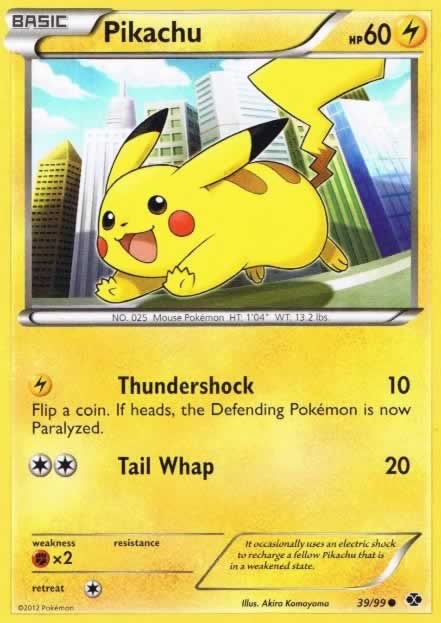
Pikachu, as you can see here, is the type of Pokémon card that you’ll find yourself coming across a lot. But why? Let’s break it down:
probably the most important part of the card for most people is what it says (or, more specifically, shows) at the bottom righthand corner. The furthest symbol to the right is the set that this Pikachu card came from (which we will get to later), while the dot next to it and the numbers is the card’s identifying number in that set, and the rarity. In this case, Pikachu is a common card, as its rarity is a circle. How do we know this? Because each symbol signifies a different rarity, as so:
- Common card = black circle: these cards, as the name suggests, are the most common of the lot. Chances are, you’ll run into a lot of these, and will often find yourself with multiple copies of the same card. Contrary to what you may think, multiple copies of one card isn’t bad at all in most cases, but in fact, great! With more than one copy of a card in your possession, you can easily trade it to someone who doesn’t have it, or if you are a competitive player, you may need multiple copies of one card to be able to find it in your 60 card deck (which will happen a lot!). Also, when people refer to ‘bulk’, they generally mean unwanted common cards that they have no use for because they have so many.
- Uncommon card = black diamond: these cards are a half-and-half scenario. You’ll have a lot of them, but probably not as many doubles as you will with common card. Most English booster packs will contain 3 of these cards, as opposed to the 4-5 common cards you might get. You’ll find a lot of people still selling these for a cheap-to-moderately cheap price online, as sometimes an uncommon card can be hugely valuable in competitive play, which shows that it’s not always the rarest cards that are the best!
- Rare card = black star: naturally, rare cards are the heavy hitters that people are looking for. They are the strongest, coolest, and coolest cards to get.
Okay, so with those basic rarities in mind, it’ll be easier to explain these next few. It would be strange to call them ‘advanced rarities’, but they are a little different to explain, and not necessarily reliant on the symbol in the corner:
- Holographic/Holofoil rare = black star + shiny (holofoil) picture: a holofoil rare is a rare card but the picture of the Pokémon is shiny. This shine is where the name ‘holographic’/‘holofoil’ rare comes from, as the coating is made from holofoil. Unlike the other rarities, holofoil rare cards are not guaranteed in most Pokémon products. Instead, they are a bigger prize that most collectors desperately chase, sometimes going as far as to shun regular rare cards as ‘bulk’. There’s a much higher prestige with these cards, and if you watch YouTube unboxing videos like so many people do, these are the cards that the unboxers begin to scream with joy at in their videos. Also, it’s handy to know that anything with ‘holofoil’ in the title is colloquially referred to as ‘holo’ or ‘holos’ – this is more for convenience when the cards start to have long names for their rarities (like the next rarity we’ll talk about).
- Reverse holographic/holofoil rare = black star + shiny card (excluding picture): reverse holo rares are essentially the opposite of a holo rare. Instead of the picture being shiny, the rest of the card is shiny. Contrary to what you may believe, reverse holo rares don’t have the same prestige as holo rares, but are still highly valued. There isn’t a definite reason for this other than the appeal. See, a holo rare has a different type of holofoil, where the shine contains a pattern. This pattern differs between sets, but some classic styles include the ‘cosmos holofoil’, which lasted all the way from the first Base Set (1999 in the English release) until Call of Legends (2011). This holofoil featured a pattern of sporadic dots, appearing like stars or the ‘cosmos’. There are also patterns on some reverse holo rare cards, but they are less sought after.
- Ultra rare (sometimes referred to as a super rare) = black star? Shiny card?: as you can tell, what defines an ultra rare is significantly harder than a rare card, but when you see one, you’ll definitely know. For the most part, ultra rare cards have the black star present on other rare cards. The biggest difference is that ultra rare cards are in a league of their own, in the sense that they are a different type of card all together. Also, they are ridiculously hard to come by, with many people resorting to buying booster boxes (an entire box of booster packs), or paying a decent sum of money for a single card trying to collect them. So, to clarify this a little more, here’s a sub-list:
Different types of ultra rare cards:
- Pokémon EX (spelled Pokémon ex in early sets, and clearly defined by the ‘EX’ next to the Pokémon’s name): these ultra rare cards are just as flashy as they are powerful. The ‘EX’ part of their name stands for ‘extra’, and that sums up the extra abilities that they possess over other cards. Currently, EX cards have just gone out of fashion, with the new generations focusing on GX cards more. Truth be told, it is highly unlikely that you’ll come across one of these cards at random, but that’s nothing to fear, as you won’t have to find them by used card resellers either. These cards are frequently offered in their own TCG products, usually displayed prominently through the plastic packaging, so that you know just how great they are. Another great thing about them is that they are usually basic Pokémon, meaning that you can play them as soon as they come into your hand. However, one important thing to note is that because these cards are so powerful, they have restrictions placed upon them, namely; when your opponent knocks out (defeats) an EX card in play, they can take 2 prize cards instead of 1.
- Pokémon GX (clearly defined by the ‘GX’ next to the Pokémon’s name): okay, so these are basically same as EX cards, except that GX cards aren’t necessarily basic Pokémon like EX cards. Instead, you have to evolve your Pokémon into GX cards like you would with a Stage 1 or Stage 2 card. Moreover, GX cards also have a ‘GX’ move, which is a move so powerful that it can only be used once in the entire game. However, recently, Pokémon has introduced ‘Tag Team GX’ cards. These are GX cards with two Pokémon depicted on them, and since they have an added Pokémon, they have added strength, too, namely in the form of a cool GX ability. But, as a side effect, Tag Team GX cards are restricted by the opponent taking 3 prize cards instead of 2, like a normal GX card.
- Pokémon Legend (‘Legend’ stated in gold font next to the Pokémon’s name): these cards are much different to the other mentioned rare cards, for the simple factor that they are not one card. Instead, you need two cards to combine them as one Pokémon in play (which also means that they are treated as two when they are knocked out, and thus your opponent gets 2 prize cards. This makes them especially rare, as they were exclusive to the now outdated Heart Gold and Soul Silver sets, and since they were comprised of two ultra rare cards, you really had to work to find them both.
- Pokémon LV.X cards (‘LV.X’ stated next to the Pokémon’s name): LV.X cards are like an extra ‘level’ or ‘stage’ for your Pokémon cards. You place them on top of an existing card, and then they gain its previous attacks, but adds a few new ones. Although, it’s unlikely you’ll see one of these cards anytime soon, as they don’t have the same nostalgia factor as some of the other older cards, but are still outdated, beginning in the Diamond and Pearl era, and ending with Platinum’s Arceus expansion.
- Pokémon Prime (border surrounding picture features a ‘bursting’ effect, and Pokémon are depicted with a ‘glaring’ eye): these cards function exactly as a normal Pokémon card would under any condition, except for that they are rarer, and more powerful. They were exclusive to the Heart Gold and Soul Silver sets.
- Pokémon Star (golden star present next to Pokémon’s name: these cards aren’t so much special in play as they are cool to look at. In the Pokémon video games, there are shiny Pokémon, which are a rare form of Pokémon that feature a different colour and are extremely difficult to find. Pokémon Star cards are essentially the TCG version of shiny Pokémon, depicting a different colour Pokémon on a card, and also being very rare.
- Pokémon BREAK (horizontally positioned card/artwork, golden Pokémon coloring + metallic holofoil background): Pokémon BREAK cards work similar to LV.X cards. They are basically another evolution/stage for your Pokémon, but the major difference to the other ultra rare cards lies in their distinctive artwork and positioning when playing them. Unlike most of the other cards mentioned, when playing a Pokémon BREAK, you’ll be placing them horizontally on the Pokémon that they evolved from. In terms of rarity, BREAK cards were apart of the now-ageing X and Y generation, so they’re becoming harder to find, but are still available in some places.
Secret rare cards:
Secret rare cards are an entirely new level of rarity. Common, uncommon, rare, and ultra rare cards all share a feature in that they all show their number in their respective set.
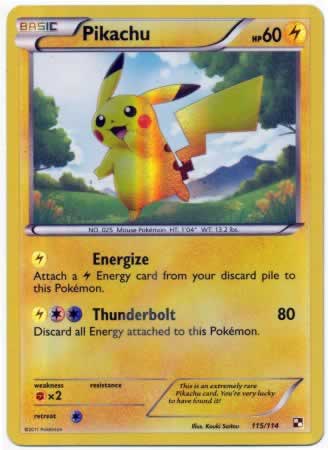
For example, the Pikachu card we displayed shows the number 39 out of 99 (39/99), which means it is the 39th card in a set of 99 cards. However, more often than not, sets also have secret rare cards that go beyond the set’s number. In this classic secret rare Pikachu card from the Black and White set (pictured below), you’ll notice that the number in the bottom righthand corner says ‘115/114’, which is clearly one number higher than the set’s total. This is why it often pays to research about how many cards are planned to be released in a set, as you may get a clue to how many secret rare cards that you should be looking out for!
Most of the time (but not always), secret rare cards will feature a holographic star symbol for the rarity, instead of a plain black star for a regular rare card. Also, they can look hugely different to ultra rare cards, or subtly similar to a regular common card. For example, you might come across an awe-inspiring card like this secret rare Zekrom card (pictured below), and its entirely gold-painted artwork:
Yet, where you might find a very obvious example of a secret rare like that golden Zekrom, you may also find exceptionally hidden secret rare cards, which might go unnoticed if you don’t check twice. A good example was that secret rare Pikachu card we showed earlier, but another is this secret rare Charmander (pictured below) from the Diamond and Pearl era:
Unless you saw the numbering on that Charmander, you’d be forgiven for mistaking it for a regular holofoil rare. But, even then, often secret rare cards have added intricacies as a bonus for finding them. This Charmander, for example, has golden yellow borders instead of the silvery grey of the era.
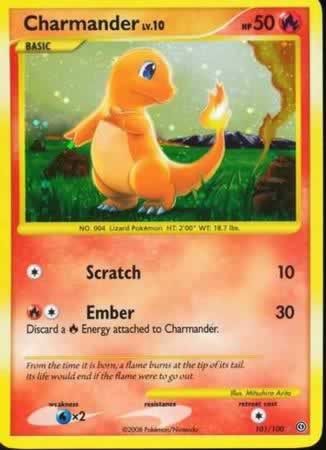
Understandably, secret rare cards have a much lower pull-rate (chance of getting, or ‘pulling’ it from a product), and it is common to go through entire booster boxes without a single one falling into your hands. This can be made immensely harder by the fact that some secret rare cards were ‘box toppers’, which are cards that come separately with each booster box bought. Though that gives a guaranteed aspect to secret rare cards, most box toppers in the Pokémon TCG are reminiscent of a bygone era, with the last appearing in 2006’s EX Holon Phantoms set.
Promotional cards are also integral to understanding card rarities because more often than not, a card will only be offered as part of a certain promotion. The cards are simply referred to as ‘promo cards’, but are also known as ‘black star promo cards’. They are clearly marked as promo cards by the black star on them that says ‘promo’. An example is this Dragonite promo card (shown below), which came with the first movie:
Promo cards are a mixed bag in terms of rarity. Some are so sought after that they are fetching astronomical prices from resellers, whereas others become worth almost nothing. Generally, this is dependent on two things.
- The price of the promotion: some promotional cards are only available in products that are already quite expensive to begin with. If you were to buy a Mega Salamence EX Premium Collection Box, per say, the starting price was already high when it came out, and now, since it’s aged a little, the Mega Salamence promotional card that it contained has raised in price as well.
-
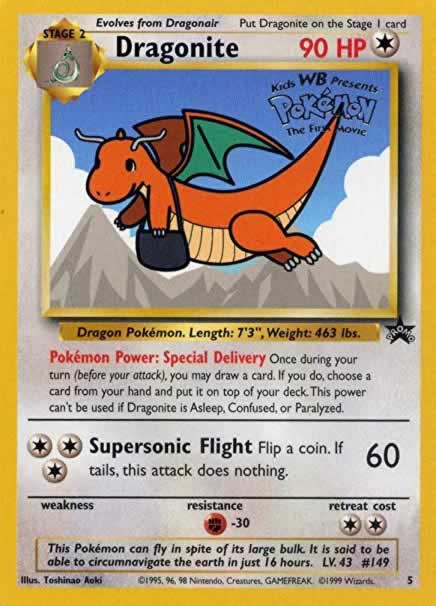 The availability of the promotion: some promo cards become worth a lot less than others, as they are relatively easy to obtain because the promotion is readily available. A generic blister pack that contains a promo card, won’t be worth as much because it is cheap to begin with, readily available almost anywhere, and the cards themselves usually aren’t that sought after. On the flip slide, a promo card that comes exclusively with a movie ticket to a Pokémon movie might be worth a lot more, as you would have actually had to buy the movie ticket at the time to see it, and since movies usually aren’t in theatres that long, the chance will pass by quickly.
The availability of the promotion: some promo cards become worth a lot less than others, as they are relatively easy to obtain because the promotion is readily available. A generic blister pack that contains a promo card, won’t be worth as much because it is cheap to begin with, readily available almost anywhere, and the cards themselves usually aren’t that sought after. On the flip slide, a promo card that comes exclusively with a movie ticket to a Pokémon movie might be worth a lot more, as you would have actually had to buy the movie ticket at the time to see it, and since movies usually aren’t in theatres that long, the chance will pass by quickly.
Last, and not least, we have cards with fixed rarities. These cards are different to the others in their rarity because it is not the chance of getting them that defines how rare they are. Instead, they are all fixed to have the same rarity. These cards aren’t especially common because there are only a select few ways that you can obtain them, which are through products like trainer kits and half decks. An example of this would be the Sun & Moon Trainer Kit: Lycanroc & Alolan Raichu, containing a Lycanroc half deck, and an Alolan Raichu half deck. If we take

Lycanroc (shown below) from the Lycanroc half deck for example, you’ll notice that the rarity in the bottom left corner doesn’t display the usual black circle, diamond, or star that it would to define its rarity, but instead, there’s a silhouette of Lycanroc. If a card has a silhouette of a Pokémon like this, it means that it has a fixed rarity as part of a set. Also, the set’s number will be very small (around 30), as the entire set will come complete with the product that you received the fixed rarity cards in. All in all, while these cards are a cool way to quickly collect an entire set, the reality is that they aren’t really worth anything special. They are more of a product to help people get into playing the game, rather than collecting cards for rarity.
But, that’s enough about Pokémon card rarities. What else do you need to know? The rest is much simpler, and we can use this Giratina card (pictured below) as an example:
Despite this card’s age, it shows everything as clearly as we need. Here’s a list of what each part of a card should show:
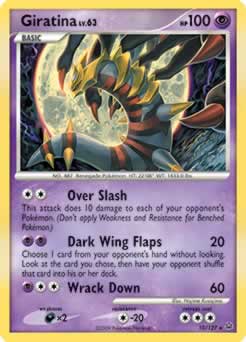
- The top: here, you will find the Pokémon’s name, what stage it is (basic, stage 1, stage 2, EX, LV.X etc.), how many hit points it has (e.g. ‘HP 100’), and the Pokémon’s type with the symbol in the righthand corner (which is usually mirrored by the color of the card as well).
- The picture: here you’ll see the Pokémon itself, obvious clues to the rarity (such as whether it is holographic or not), and also whether you have a misprinted card (which can be very rare, mind you!).
- The middle: all the information about the Pokémon’s abilities and attacks lie here. There are some variations between generations, such as Pokébody or Poképower, which are now simply known as abilities. Everything here is very straightforward, as the text serves as an explanation on how to use the card.
- The bottom: this is the most important part of the card for collectors. Again, there are slight variations between sets, but mostly, it should include: weakness, resistance, retreat cost, the date the card was printed, the artist’s name, the number the card is in the set, the rarity symbol, the set symbol, and copyright information. A key to understanding Pokémon set symbols isn’t an easy explanation, or something that you’d be very likely to memorize. Each set has an entirely different symbol, so your best option is to google search for a list of them and compare your cards to it.
That’s about all there is to know about Pokémon cards, but what about trainer and energy cards? Honestly, they are much the same, with a few differences.
Trainer cards are divided into four main categories, and four lesser-used categories, all of which can feature the rarities that we mentioned earlier:
- Supporter cards: these cards can only be used once per turn, but that’s only because they are so integral to success in the game. They feature the artwork of a character or ‘supporter’ from the game or anime, so the designs can often grab people’s attention. The ultra rare versions that feature enlarged ‘full art’ artwork are the most popular because of this, as people tend to find great appeal in seeing their favorite characters with bigger and better artwork.
- Item cards: unlike supporters, you can use these as many times as you want, but they usually aren’t as powerful as a result.
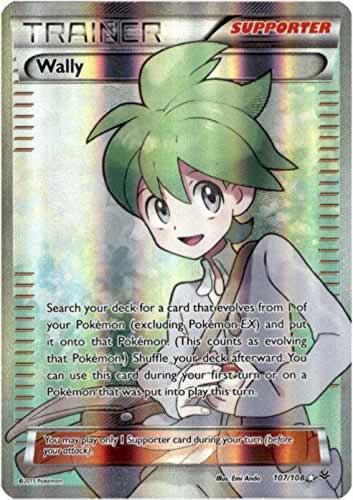
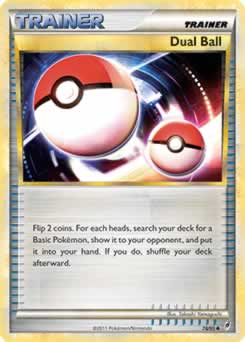
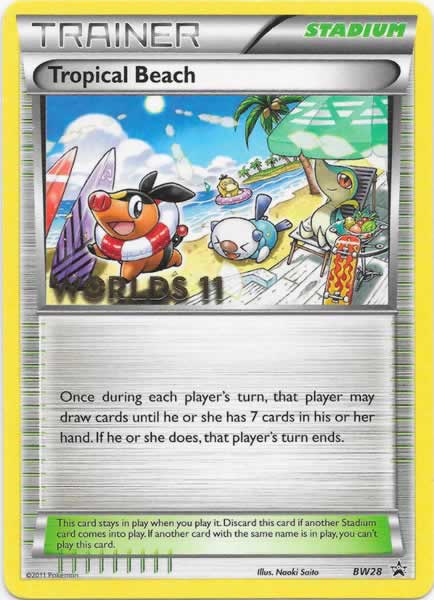
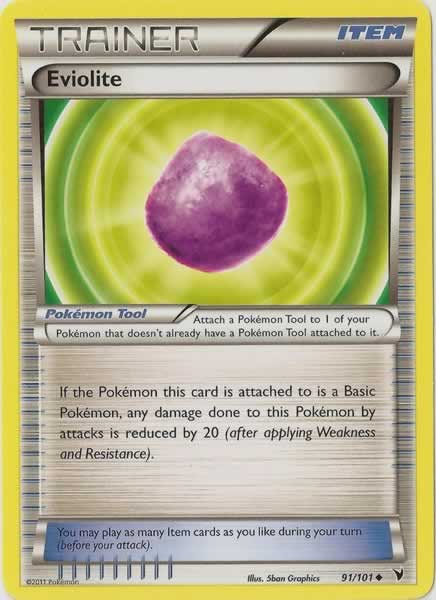
From left to right: A Full Art Supporter Card, An Item Card, Stadium Card and Pokemon Tool Card.
- Stadium cards: these cards aren’t as used in the game, which is likely due to their practicality. Unlike the other trainer cards, once they are set down in play, they stay in play until another stadium card replaces them. They act as an added effect to gameplay, with conditions being set upon both players. A notably rare stadium card was the 2011 Pokémon TCG World Championship’s Tropical Beach Stadium, which was only available to people who attended the championship itself.
- Pokémon Tool: these cards attach to your Pokémon in play, and are often extremely useful. Some become very sought after, with the Eviolite Pokémon Tool card having many examples of decks that it shined in.
The lesser-used categories among trainer cards are as follows:
- Technical Machine: these cards work similar to items or Pokémon Tools, but instead, they list an attack, giving them a similar feature to what they have in the video games.
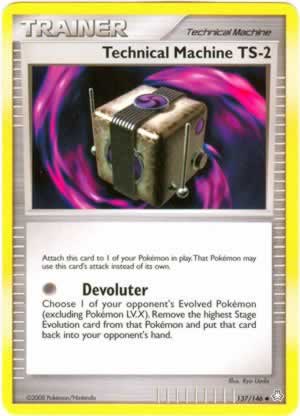
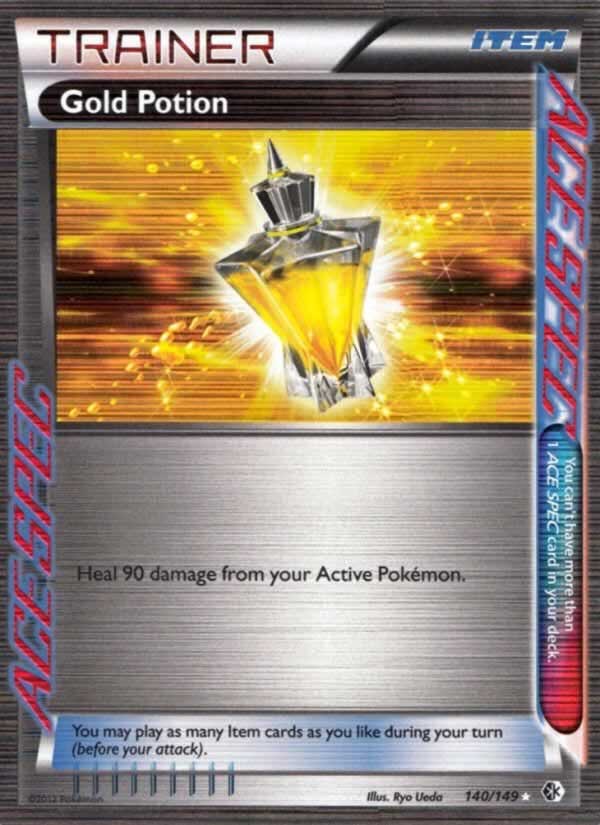
1. A TM Card (Left), 2. An Ace Spec Card (Right)
- Ace Spec: while Ace Spec cards are insanely powerful, they can be considered lesser used, as they have severe restrictions placed upon them to limit this power, namely; there can only be one of them in your deck. As a result of this, not only are Ace Spec cards extremely useful (if you can use them), but they are also quite rare and expensive, so they’re definitely cards that you should keep if you come across them.
- Rocket’s Secret Machine: like Technical Machines, Rocket’s Secret Machines are a special type of trainer/item. Except, they don’t really feature anything definite about them, other than the ‘Rocket’ in the name, and some slightly sinister ways of using them. Since Team Rocket aren’t a large part of the franchise anymore, frequently being replaced by other teams like Aqua, Magma, Galactic (and the list goes on), they’ve aged since we’ve last saw them, and thereby, their rarity is going up, too.
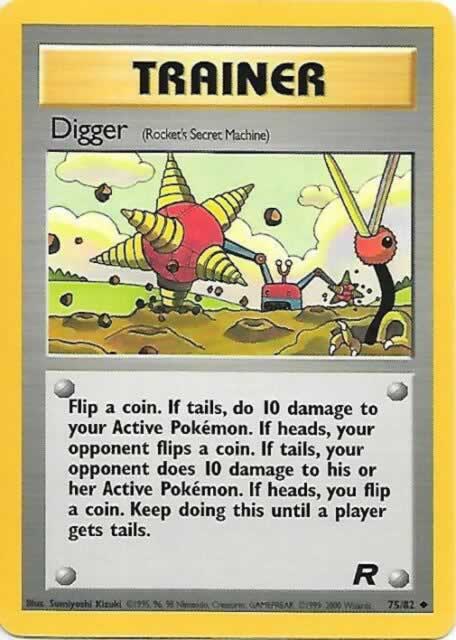
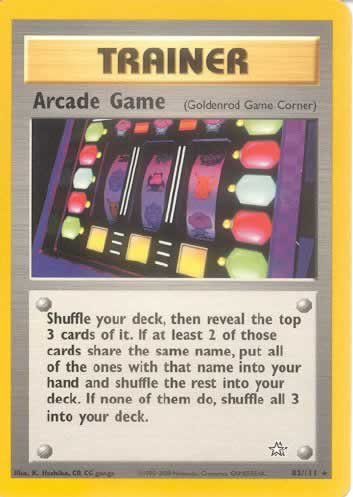
- Goldenrod Game Corner card: these are the least used of all trainer cards. They don’t really do anything special, but are more for the appeal of being themed after the Goldenrod Game Corner. Again, they’ve aged a lot, and you likely won’t be seeing them unless you specifically search for them online.
Energy Cards
Energy cards are exceptionally straightforward. They don’t really change much, and are just used to show what energy they provide for your Pokémon in play. But, there are a few variations:
- Regular energy cards: these energy cards are just that – regular. You’ll see them more than any other card in play, and they’re the heart and soul of the game. While they’re not special to collect, it’s always good to have a decent amount of them in each typing, so that way you always have the ones you need at your disposal:
- Alternate artwork energy cards: these cards come with exclusive artwork, which gives them a heightened sense of prestige, as they look cooler. Overall, however, they aren’t really gawked at the same way as other rare cards might be. An example is the Generations set’s energy cards, which featured a striped effect on the artwork:
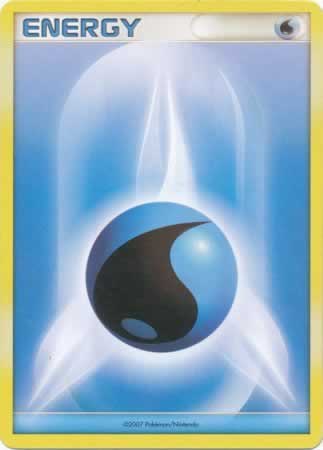
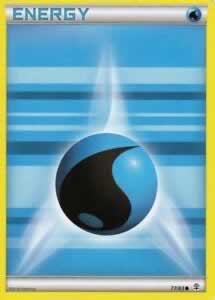
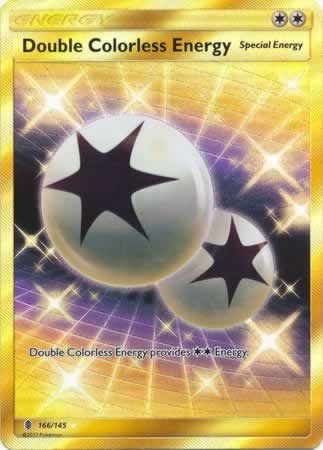
From left to right: A standard energy card, alternate art energy card from the Generations Set and a Secret Rare Special Energy Card.
- Special energy cards: these cards work differently to the standard energy cards, and they will explain how they do on the card. One of the most notable is the famed Rainbow Energy card, which allowed players to use it in place of any energy card that they wanted. These cards can be rarer than most energy cards, as they are usually exclusive to the set that they are released in, with only a few popular ones receiving reprintings, such as ‘Double Colorless Energy’. It is important to note, however, that energy cards (just like trainer cards) can be uncommon, rare, ultra rare, or even secret rare cards, too. An example of a secret rare energy can be shown in this Double Colorless Energy (shown below):
Okay, so we’ve talked about the cards themselves, but how will you get them? How do you know what you’ll get, and how can you cater your choice to better suit you? The answer lies in understanding the different types of Pokémon TCG products:
Booster Packs
Booster packs lie at the forefront of each and everyone’s Pokémon TCG collection. They are a product that contains approximately 10 cards, but can sometimes have different amounts depending on the set, or region around the world. But, for the most part, its 10 cards in a standard English booster pack. These packs are a cheap way to quickly gather random cards, but you’ll never really know what you’ll get, as they are sealed in opaque, metallic packaging. Generally, there is a system to the random cards inside the packs, though, which is as follows: 1 rare card (which may also be an ultra rare or a holo rare), 3-4 uncommon cards, and 4-5 common cards (or the remaining number in the packaging). This system is subject to change, but is generally what people consider when weighing in the odds of whether or not they’ll pull a rare card that they want from the pack. There’s also an order that the cards are placed in the booster packs, which sporadically changes between sets. This isn’t so important, but some people like to memorize it before they open booster packs, so that they know which card will be the rare one, and can look at it last to add an element of suspense.
Another point of interest are booster boxes, which are boxes with many booster packs inside them. There’s not much to say about them, but if you become a serious collector, you’ll often hear about people buying booster boxes to increase their chances of pulling rare cards from booster packs. Also, though it many cost a lot to buy a booster box, some simple math will prove that its often better to buy one booster box than the equivalent in separate packs.
Blister Packs
Blister packs are similar to booster packs, but are a little more expensive, as they guarantee a certain card. They feature one card that’s already visible, which you know you’ll get, and is the selling point of the packs, as well as some booster packs. The amount of booster packs, and other items (such as coins or pins) is subject to change depending on the specific blister pack you buy, but you’ll always know, as it will be clearly stated on the packaging.
Theme Decks
Theme decks are the ultimate product for beginners, and that’s nothing to scoff at! They’re great for many reasons, and are basically the complete overview of the Pokémon TCG for new players. Often, more experienced players will buy these as well, as they often offer many energy and trainer cards that are much needed for their decks at an affordable price. Theme decks usually contain: a rulebook, a playmat, a coin, a complete 60 card deck (which will have some nice rare holofoil cards, too!), and damage counters for playing with. The only major drawback to theme decks is that they can be substantially weaker that the decks that competitive players may use at a tournament, so they are more practical for casual play, or testing out new cards.
Trainer Kits/Half Decks
Trainer kits are an expanded version of theme decks, which are specifically targeted for beginning trainers in providing a foundation for them to start with. Rather than one 60 card deck, two 30 card half decks are contained in them. These decks are a great way for two people to immediately begin playing the game, and as a supplement to this, rulebooks, coins, damage counters, and sometimes even booster packs are added as well to give players the complete experience.
Boxes/Collections
Boxes and collections are what the more experienced players are usually looking out for. There are many variations in these products, but they are noticeably different because they contain a promotional ultra rare card that competitive players/collectors are excited to get, and a variety of booster packs. The contents are subject to change, but boxes and collections are very useful for a multitude of reasons, and definitely aren’t something to ignore. They can become expensive, however, so its best to do your research and decide which one will be the best option for you before purchasing.
Elite Trainer Boxes
The ‘elite’ in the name defines the difference between elite trainer boxes and regular trainer kits. They serve as a boost for the competitive players catalogue of cards and necessities for the game. They contain: approximately 8 booster packs, card sleeves (used to protect your cards in play/when on display), various energy cards of each typing, status condition markers (e.g. poison/burn counter), dice (used in place of damage counters), a die (instead of a coin for coin-flip moves), and usually a player’s guide as well. As you can tell, this is a lot, and is all centered towards competitive players, so while it may not be the best purchase for a beginner, intermediate-experience players are fond of these boxes.
Tins/Chests
Tins/Chests are more of a gimmick product, but do also have some practical use. They are a metal tin, or a chest that contains various pieces of merchandise, and an ultra rare card. However, the tin/chest aspect is still useful, as it can be a great place to store bulk, and the designs can look great as well.
Where to Buy/Obtain Pokémon TCG Products
The final question that will come to mind is where you’ll even begin to get any Pokémon TCG products as a collector. This is relatively simple, and not something that should worry you too much, unless you are looking for a very specific product from yesteryear.
Retailers
Most retailers will carry Pokémon TCG products of some kind, the most common of which are your chain-stores like Kmart, Target, Walmart, or whatever else there may be in your area. Another common option are games stores, which will likely specialize in card game products, but may also be a little more expensive as a result. Finally, there are some more obscure stores that you should still consider. For example, some newsagents are known to carry booster packs, and small giftshops of discount stores may have some products, too.
Online
For many, online is the best option. It’s cheap, you have an unlimited selection, and you can even buy specific cards that you need. There’s only two immediate drawbacks to online purchases, and that’s reliability and postage times. If you are buying from a reliable, affordable and fast-paced service like Titan Cards, you won’t have to worry, but some other retailers, such as eBay, are known to have fake cards and scams on them. This is why it pays to be knowledgeable about fake cards, and shady tactics. Also, if a card is in particularly high demand, price markups are common, so it’s best to be fast and efficient in buying off the internet. That being said, online is still one of the most common and affordable ways to receive cards, and often takes a lot of the difficulties in travelling around to find a certain product away.
Of course, we’d recommend ourselves at Titan Cards for our low prices, and guaranteed quality if you’re buying online, and that’s not to be selfish! We have the credentials to prove it, and you can check out some of our reviews that other customers have left to see the satisfaction we guarantee!
Meetups/Local Tournaments
So, once you get into playing the Pokémon TCG regularly, you’ll find yourself going to a few meetups and local tournaments. These aren’t just for playing competitively, as people will be there to swap, trade and sell cards with each other, which is great if you have a lot of cards you don’t know what to do with, or think that you can strike a deal with a rare card you have.
Final Words
Overall, it’s a lot to think about! There’s a lot involved in the Pokémon TCG, and as you probably noticed, you have so many choices when it comes to collecting. But, the best thing is that this gives you a lot of flexibility, and you never have to stick to one specific way of collecting or playing. If there’s anything you should know going forward, it’s that its undoubtedly important to keep yourself updated on the latest products, and research what you are buying. In doing this, not know will you know the products better, but you’ll protect yourself from making the wrong decision, and you’ll also likely discover something new that we haven’t even mentioned!






